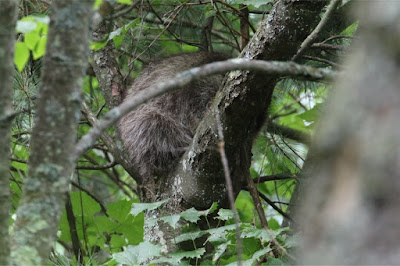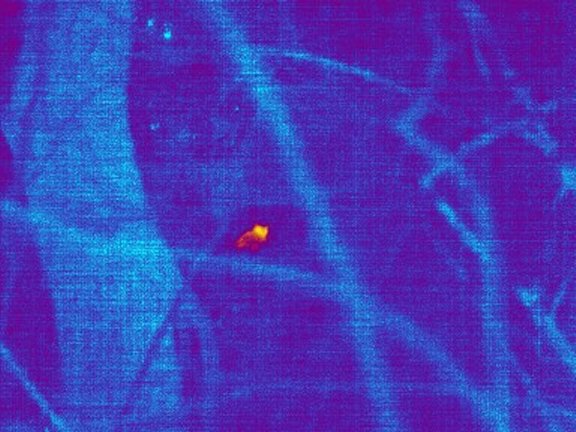On a cloudy summer day I explored the new Logan Hill Preserve with my ThermApp. Much like a typical outing in the woods with a thermal camera, you quickly run across a squirrel or a chipmunk:
Shortly thereafter, the camera found this much larger hotspot high in a distant tree:
It's hard to tell for sure, but it looks like a raccoon:
Here's another view of that same probable raccoon:
There were certainly other raccoons in those woods, as I soon had this guy come traipsing down a log, seemingly unaware of my presence.
Anytime you're in a forest with cavitied trees and a healthy population of rodents, you come across warm spots like this:
I have no idea what's in there, but that space between the bark and the trunk of the dead tree certainly looks like a good resting spot for some critter.
Here's another such warm spot in a fallen tree:
Bringing up my binoculars, I saw a strange face staring back at me, so I got closer:
Can you tell what it is from that thermal image?
When using my ThermApp to seek out wildlife, I'm always looking for warm spots, because those are what stand out against the background. But in this case, the face staring back at me was a toad, and it is colder, not warmer, than the surrounding. (More precisely, it is approximately the same temperature as the surrounding, being "cold-blooded" and all.)
So I guess it was just a coincidence that while investigating a warm spot in a tree I happened to locate this cold-blooded animal instead. Or, you could also conclude that that toad decided to hang out in that cubby precisely because it is slightly warmer than its surroundings! Meanwhile, the source of that warmth, either some critter deeper inside that log, or perhaps just wood rot, remains unknown.
Shortly thereafter, the camera found this much larger hotspot high in a distant tree:
It's hard to tell for sure, but it looks like a raccoon:
Here's another view of that same probable raccoon:
There were certainly other raccoons in those woods, as I soon had this guy come traipsing down a log, seemingly unaware of my presence.
Anytime you're in a forest with cavitied trees and a healthy population of rodents, you come across warm spots like this:
I have no idea what's in there, but that space between the bark and the trunk of the dead tree certainly looks like a good resting spot for some critter.
Here's another such warm spot in a fallen tree:
Bringing up my binoculars, I saw a strange face staring back at me, so I got closer:
Can you tell what it is from that thermal image?
When using my ThermApp to seek out wildlife, I'm always looking for warm spots, because those are what stand out against the background. But in this case, the face staring back at me was a toad, and it is colder, not warmer, than the surrounding. (More precisely, it is approximately the same temperature as the surrounding, being "cold-blooded" and all.)
So I guess it was just a coincidence that while investigating a warm spot in a tree I happened to locate this cold-blooded animal instead. Or, you could also conclude that that toad decided to hang out in that cubby precisely because it is slightly warmer than its surroundings! Meanwhile, the source of that warmth, either some critter deeper inside that log, or perhaps just wood rot, remains unknown.



























